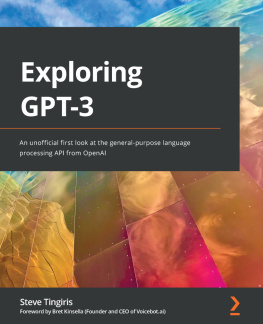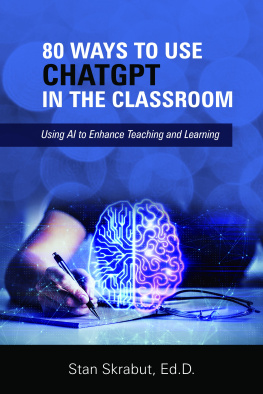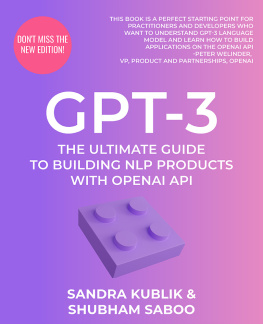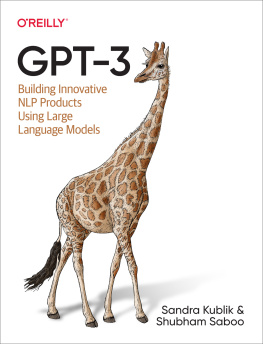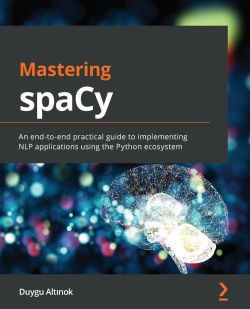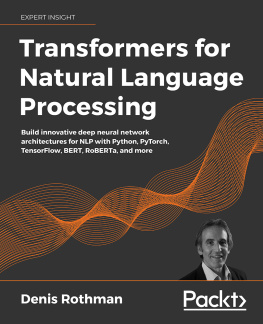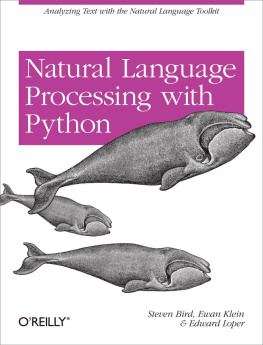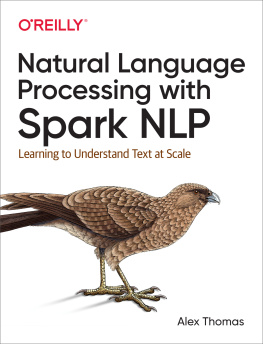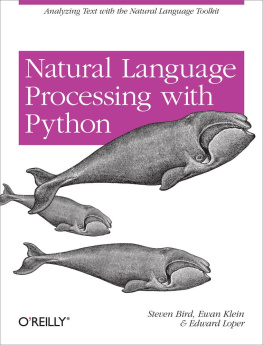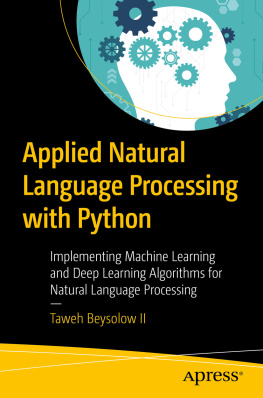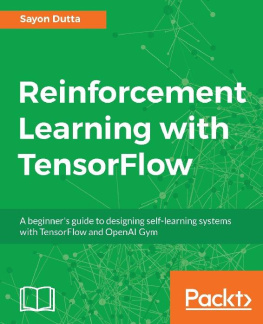Steve Tingiris - Exploring GPT-3: An unofficial first look at the general-purpose language processing API from OpenAI
Here you can read online Steve Tingiris - Exploring GPT-3: An unofficial first look at the general-purpose language processing API from OpenAI full text of the book (entire story) in english for free. Download pdf and epub, get meaning, cover and reviews about this ebook. year: 2021, publisher: Packt Publishing, genre: Home and family. Description of the work, (preface) as well as reviews are available. Best literature library LitArk.com created for fans of good reading and offers a wide selection of genres:
Romance novel
Science fiction
Adventure
Detective
Science
History
Home and family
Prose
Art
Politics
Computer
Non-fiction
Religion
Business
Children
Humor
Choose a favorite category and find really read worthwhile books. Enjoy immersion in the world of imagination, feel the emotions of the characters or learn something new for yourself, make an fascinating discovery.
- Book:Exploring GPT-3: An unofficial first look at the general-purpose language processing API from OpenAI
- Author:
- Publisher:Packt Publishing
- Genre:
- Year:2021
- Rating:5 / 5
- Favourites:Add to favourites
- Your mark:
Exploring GPT-3: An unofficial first look at the general-purpose language processing API from OpenAI: summary, description and annotation
We offer to read an annotation, description, summary or preface (depends on what the author of the book "Exploring GPT-3: An unofficial first look at the general-purpose language processing API from OpenAI" wrote himself). If you haven't found the necessary information about the book — write in the comments, we will try to find it.
Get started with GPT-3 and the OpenAI API for natural language processing using JavaScript and Python
Key Features- Understand the power of potential GPT-3 language models and the risks involved
- Explore core GPT-3 use cases such as text generation, classification, and semantic search using engaging examples
- Plan and prepare a GPT-3 application for the OpenAI review process required for publishing a live application
Generative Pre-trained Transformer 3 (GPT-3) is a highly advanced language model from OpenAI that can generate written text that is virtually indistinguishable from text written by humans. Whether you have a technical or non-technical background, this book will help you understand and start working with GPT-3 and the OpenAI API.
If you want to get hands-on with leveraging artificial intelligence for natural language processing (NLP) tasks, this easy-to-follow book will help you get started. Beginning with a high-level introduction to NLP and GPT-3, the book takes you through practical examples that show how to leverage the OpenAI API and GPT-3 for text generation, classification, and semantic search. Youll explore the capabilities of the OpenAI API and GPT-3 and find out which NLP use cases GPT-3 is best suited for. Youll also learn how to use the API and optimize requests for the best possible results. With examples focusing on the OpenAI Playground and easy-to-follow JavaScript and Python code samples, the book illustrates the possible applications of GPT-3 in production.
By the end of this book, youll understand the best use cases for GPT-3 and how to integrate the OpenAI API in your applications for a wide array of NLP tasks.
What you will learn- Understand what GPT-3 is and how it can be used for various NLP tasks
- Get a high-level introduction to GPT-3 and the OpenAI API
- Implement JavaScript and Python code examples that call the OpenAI API
- Structure GPT-3 prompts and options to get the best possible results
- Select the right GPT-3 engine or model to optimize for speed and cost-efficiency
- Find out which use cases would not be suitable for GPT-3
- Create a GPT-3-powered knowledge base application that follows OpenAI guidelines
Exploring GPT-3 is for anyone interested in natural language processing or learning GPT-3 with or without a technical background. Developers, product managers, entrepreneurs, and hobbyists looking to get to grips with NLP, AI, and GPT-3 will find this book useful. Basic computer skills are all you need to get the most out of this book.
Table of Contents- Introducing GPT-3 and the OpenAI API
- GPT-3 Applications and Use Cases
- Working with the OpenAI Playground
- Working with the OpenAI API
- Calling the OpenAI API in Code
- Content Filtering
- Generating and Transforming Text
- Classifying and Categorizing Text
- Building a GPT-3 Powered Question-Answering App
- Going Live with OpenAI-Powered Apps
Steve Tingiris: author's other books
Who wrote Exploring GPT-3: An unofficial first look at the general-purpose language processing API from OpenAI? Find out the surname, the name of the author of the book and a list of all author's works by series.

